Hallman’s Resurgence
How the Oklahoma pro has gone from burnout to one of the winningest on Tour
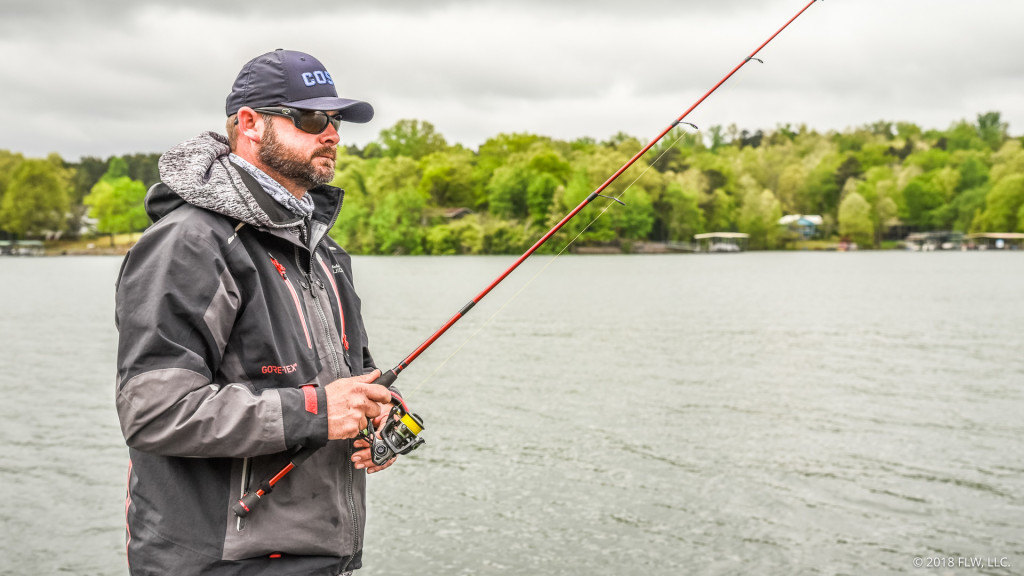
In the span of two and a half years, Bradley Hallman of Norman, Okla., has won a quarter million dollars on the FLW Tour. Since joining the FLW Tour in January of 2016, he has fished 17 Tour events, won two of them and cashed checks in five more. Considering there are pros who have been fishing the FLW Tour for 10 years with no Tour wins, Hallman’s track record is looking pretty good for this being only his third season.
But Hallman is no small fry in the professional bass fishing pond. There is a lot more to his story than his Tour wins on Lake Okeechobee and Lake Lanier.
Long before his successful FLW Tour campaign began, Hallman had started another pro fishing career on the B.A.S.S. Elite Series. Hallman is the first to admit that his first attempt at professional bass fishing did not go too well. Instead of career wins blossoming on his resume, his tenure on the Elite Series from 2006-2011 was more about disappointment, despair and a lot of soul searching about whether this sport was the right thing for him to be doing – or not.
With his second attempt at a pro career on the FLW Tour well underway, I joined Hallman on his third day of practice on Smith Lake to find out more about what’s driving his successful resurgence this time around.
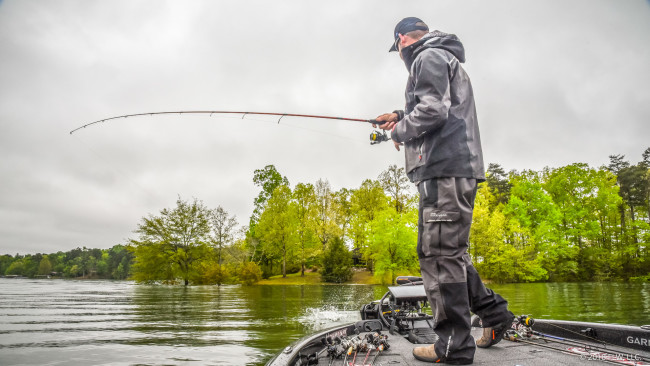
“Your mind has got to be right to do this,” Hallman says as he slides a buzzbait up under wading trees in flooded pockets at Smith, where the water has come up 4 feet since practice started. “But there are so many layers to your mind being right – health, family, finances, friends – just to name a few. All that has to be in order to have a clear mind – an open mind to make adjustments on the water minute to minute.”
Hallman’s first push into the Elites in 2006 and 2007 was respectable. He managed to earn $10,000 checks in half of the events each year. In 2008 and 2009, Hallman experienced an uptick in performance, cashing more checks and bigger checks for better finishes.
But in 2010, the wheels started to come off.
“In the summer of 2009 my dad died from cancer and looking back, that sort of started the downturn,” Hallman recalls. “At that same time my wife and I were starting a family with two little girls. Going into the 2010 Elite season was the first time I remember that feeling of not wanting to be at tournaments. I would get to events and just sort of go through the motions without really being there mentally.”
He checked in the first event of 2010 and then fell off a cliff, going five events in a row without another payday. He only earned one more check after that. And that’s when the financial pressure began to mount.
He hoped a fresh start to the 2011 season would give him a clean slate to work with but instead a sort of black hole began to suck him under.
“Like I said, there are so many levels to it,” he says. “My family didn’t travel with me and I missed them terribly. My wife has always supported me in my fishing, but at the same time, the guilt of going tournament to tournament with nothing to show for it started to wear on me. I expected more of myself than that. She was at home working a fulltime job and taking care of our children and it seemed like the more I pushed to get ahead, the farther behind I got. I kept thinking something had to change and go my way, but it never did.”
Hallman’s final season in 2011 was his breaking point. He made just a single check that year.
“I was so checked out mentally and so miserable,” he laments. “I didn’t want to be there. And it’s like I could never get out of the downward spiral. It was a nightmare.”
Two instances in particular stand out in Hallman’s memory as being at rock bottom.
“During one of the practices I remember fishing a seawall that ran along the backyards of some houses,” he says. “I heard kids laughing. I looked up and a dad was out playing ball with his kids and they were laughing and having a good time. You might as well shot an arrow through my heart. I knew right then I belonged at home with my family and I was a 1000 miles away.”
Then towards the end of the 2011 season, the Elites headed to Lake Murray. On the second day, Hallman didn’t have enough weight to make the top-50 cut for a check. He pulled up to weigh-in and instead of bagging his fish, he just let them go.”
“A couple of my buddies saw me do that and they were in total shock,” he recalls. “I knew then that I was done.”
Hallman couldn’t wait for the last event of that season so his pro fishing nightmare could end.
“When I got in my truck to leave that last event, it was like a 10,000-pound weight had been lifted off of me,” he says. “I couldn’t wait to get home and start my life over. I was totally done. In my mind, my fishing career was over.”
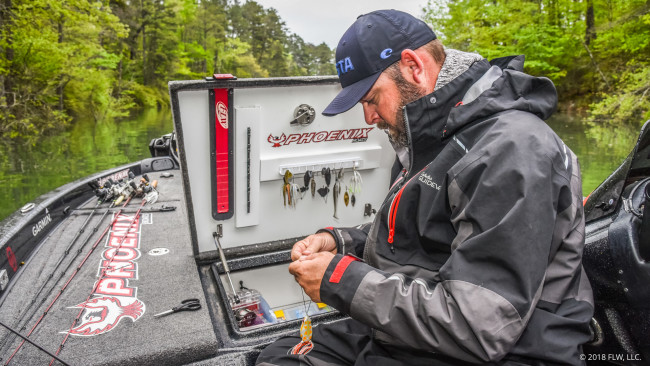
For the next three months, Hallman went into a sort of solitary confinement from the fishing world. He parked his boat and never unpacked it. He scrubbed everything fishing from his life.
“I didn’t look at the internet,” he says. “No tournament results. No tackle shopping. In fact, I wanted to sell everything – boat, rods and tackle. But my wife wouldn’t let me; she knew better; she knew fishing was my passion and someday that desire would return.”
Oddly, all Hallman wanted to do when he returned home was manual labor. He had spent 13 years in the construction business before qualifying for the Elites and that’s what he wanted to return to – in the hot Oklahoma summer.
“I went on a do-it-yourself project rampage around the house,” he says with a laugh. “I built a rather extensive patio and outdoor kitchen in the backyard. For four months I drove a skid steer and laid brick and thought a lot about my mistakes in fishing. As the old saying goes, the body fuels the mind, and I did a lot of soul searching during that time.”
After a scorching summer of self-reflection, Hallman had come to several hard conclusions about his fishing, which became the formation of some new ground rules. One, he never wanted to be imprisoned by his own fishing again. In order to do that, he knew he had to restore the fun in his fishing. Second, in order to keep it fun and avoid the traps, he would fish the way he wanted to fish.
“My six years on the Elites Series taught me a lot,” he says. “It provided me a great playbook to work from in terms of experience, but it also was like a manual of mistakes. And the number one mistake was that I became a check chaser. I felt so much pressure to get a check – to have something to show for all the money and effort I was putting into this. I started chasing all these other techniques that guys told me were ‘the deal’ on these different lakes. And the more I chased, the more I got demolished.”
By fall of 2011, Hallman had landed a new job. Thanks to the help of some close friends he had taken up the position of a Landman – a liaison between property owners and oil companies over mineral rights. The position was contract type work that still gave him time off to fish.
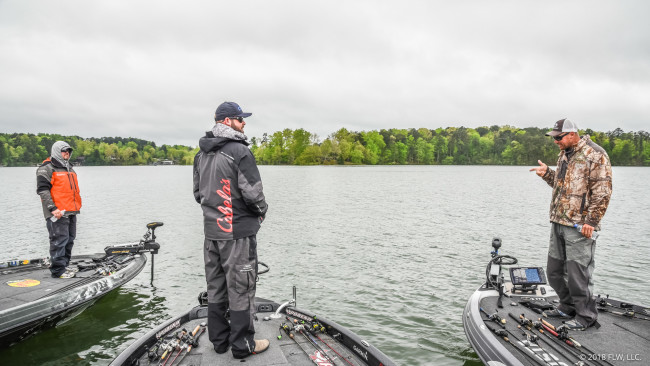
In the spring of 2012, Hallman took his first steps back into the tournament fishing world.
“I signed up for BFLs around home, rekindled some old fishing friendships and started fishing team tournaments just to have fun again.”
From there, Hallman decided to get into a couple of Triple-A level events around home.
“I wasn’t ready to travel again on a national level, but I was certainly ready to defend my turf,” he says.
After several top 10 finishes “defending his turf” Hallman set his sights on the FLW Tour in 2015.
“When I called to get in the 2015 FLW Tour, they told me I had to qualify through the Costas,” Hallman says. “Well, that lit a fire under me. I entered two divisions of the Costas (Southwestern and Central) in 2015 and became a man on a mission.”
En route to qualifying for the FLW Tour, the “man on a mission” won a Costa event at Grand and then double-qualified for the 2016 FLW Tour by finishing 6th in the Southwestern Division points and 7th in the Central Division points.
The first time Hallman ever climbed the FLW Tour stage in January of 2016 at Lake Okeechobee, he dropped 25 pounds in the scales to take the lead and never looked back. Three days later, Hallman was an FLW Tour winner his first time out.
After 10 years of blood sweat and tears, Hallman finally found vindication for his fishing career.
“It was a huge relief,” he says of the Okeechobee win. “I was having fun fishing around home, but I knew – all too well – the risks of stepping out onto a national tour again. I knew if it didn’t go right this time, I would be back at home building a second outdoor kitchen.”
Since his second win at Lanier in March, Hallman has made his second attempt at a fishing career look much easier. But he is the first one to point out it’s simply not that easy.
“I won those two events because I fished the way I wanted to fish,” he says. “And that sounds heroic and glorious, but I’ve never qualified for a Forrest Wood Cup. As my career track indicates, I’m either at the top or at the bottom, but rarely anywhere in the middle. That’s what happens when you fish the way you want all of the time.”
This week at Smith Lake, Hallman finds himself at familiar crossroads that many professional anglers struggle with, no matter how much time they have behind a fishing rod: fish in their wheelhouse for a home run or a chase a check for some money and points.
Smith Lake is full of chunky check-getting spotted bass, but with four feet of new water soon to be cresting and likely turning the other way during the tournament, the largemouth temptation is enormous.
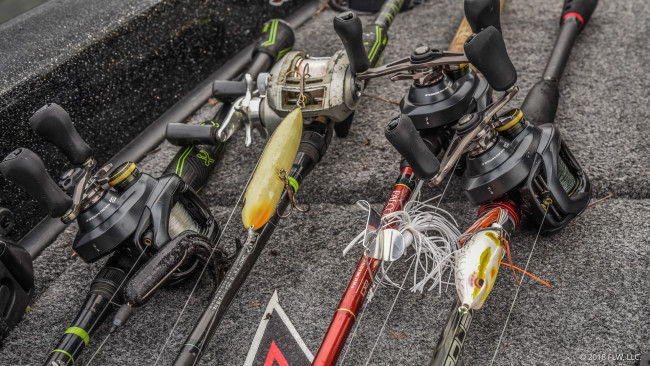
The rods on Hallman’s front on the final morning of practice tell this familiar story. To his left side are a topwater frog, a buzzbait, a big spook and flipping tube. To his right are spinning rods with a shaky head, a wacky rig and a little swimbait. Ironically, Hallman stands in the no man’s land in between.
“So here I am again totally torn,” he sighs. “Those rods on the left are what I want to be doing; these rods on the right are the ones everyone says you need to get a check. I’m fighting off the old demons right now.
“Here I am dinking around out here on these points for spots and every time I look up at the bank, I see sunken seawalls, flooded lawns, bushes and debris mats – it’s killing me.”
To add to the temptation, Hallman could hear the sound of run-ins intoning him towards the bank.
“In my heart I know the tournament-winning fish are up there. But my head keeps this spinning rod in my hand out here.”
Then Hallman takes a minute to study some uncooperative arches on his screen. Despite the familiar internal conflict and the rejection by the arches, Hallman seems totally at peace with his conundrum.
“Look at those little suckers down there ignoring my bait,” he laughs. “Ten years ago that probably would have made me miserable. But now, I’m just in a much better state of mind.”